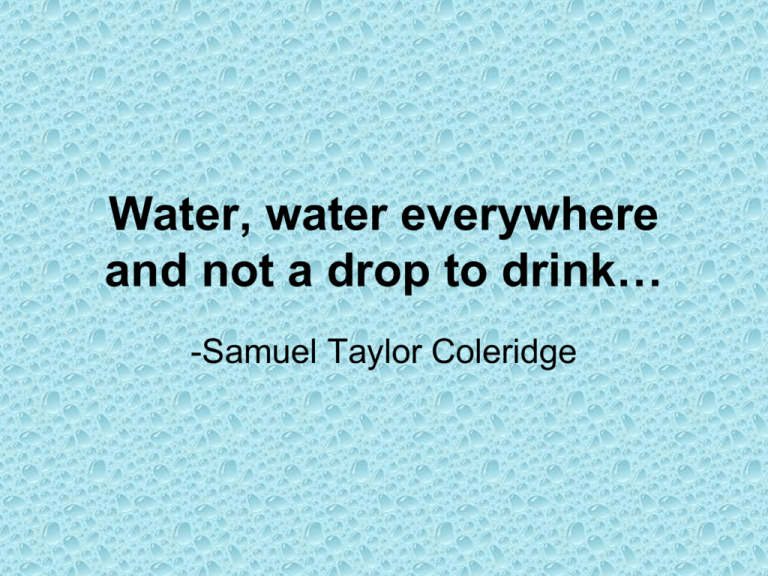Diffusion v. Osmosis
advertisement

Water, water everywhere and not a drop to drink… -Samuel Taylor Coleridge The Horse Latitudes Why Are We Not Adivsed To Drink Seawater? Water Balance • Need appx. 3L/day • Without water, no hydrolysis, temperature regulation, transport of materials HYPONATREMIA • 3 Gal/1hr = death due to loss of electrolytes (salts), causing nervous conductivity and muscle contraction to cease Which organelles maintain water balance? Why must the cell membrane maintain SELECTIVE PERMEABILITY? Kinetic Molecular Theory • Molecules are constantly in motion • Molecules want to attain disordered state / fewer collisions • Molecules will move until fewest number of collisions/least ordered state is reached BROWNIAN MOTION • Molecules are constantly moving as a result of their own vibrational/kinetic energy • This movement can be observed as BROWNIAN MOTION PASSIVE TRANSPORT • As molecules are constantly in motion, they will move without requiring the expenditure of energy by the cell Diffusion v. Osmosis DIFFUSION DIFFUSION • Passive movement of solute molecules from high concentration to low CONCENTRATION GRADIENT • Molecules will tend to move from high concentration to low concentration on their own accord (using their own vibrational energy) • Movement with the gradient is exergonic OSMOSIS • Passive movement of water molecules from high to low concentration OSMOTIC POTENTIAL • DEF: The difference between the concentration of water molecules inside and outside of cell • The larger the size of this gradient, the greater the potential for water molecules to move DYNAMIC EQUILIBRIUM • No net passive movement of solute or solvent (water) due to an equal concentration • No concentration gradient or osmotic potential Factors Affecting Diffusion/Osmosis • • • • • • Tonicity of solution outside of cell Selective Permeability of Membrane Size of Particles Weight of Particles Charge of Particles Temperature of Solvent TONICITY • Def: Relative measure of dissolved particles (solute) in the solution surrounding the cell membrane • Measurement is always compared to interior/cytoplasm of cell • Water does not have a tonic classification as it is invariably the solvent ISOTONIC • Concentration of solute outside of the cell is equal to the concentration of solute inside of the cell • No net movement of particles • DYNAMIC EQUILIBRIUM HYPOTONICITY • Concentration of particles outside of cell is lower than concentration inside of cells • If permeable, solute will leave cell to establish equilibrium with outside concentration HYPERTONIC • Concentration of dissolved particles/solute is greater outside of cell than in its interior • As a result, solute will attempt to enter the cell to establish equilibrium CYTOLYSIS PLASMOLYSIS NORMAL PLASMOLYSIS • DEF: Loss of water and turgor due to placement of cell in HYPERTONIC environment • Water leaves cell via osmosis, causing vacuole to shrink, or cytoplasm to lose volume (crenation) CYTOLYSIS • Def: Cells placed in HYPOTONIC environments may undergo cytolysis/cell rupture as water enters the cell • Loss of the lipid bilayer ultimate causes cell death TURGOR • In plants, the cell wall resists cytolysis in hypotonic environments • This turgor pressure allows the plant to resist gravity Lab: Semipermeable Membranes and Osmosis • Purpose: To analyze the movement of solutes and water across a selectively permeable membrane • Method: Tracking movement of solutes and water achieved by use of organic indicators and qualitative description of turgor (rigidity of fluid filled container) Dialysis • Loss of kidney membrane permeability due to disease or damage requires dialysis • Wastes are removed from body by passing blood through an artificial cell membrane Protocol #1 • Fill beaker 2/3rds full with tap water • Add Lugol’s solution until mixture is amber • Test water with Tes-Tape to determine if glucose is present in the bath Protocol #2 • Open wet dialysis tube using fingers and glass rod. Tie one end off with string • Using seral pipettes fill tube with starch and glucose solutions • Tie off open end. Do NOT leave space for air • Trim the strings and excess tubing Protocol #3 • Immerse “cell” in iodine-water bath • Allow to sit for 20 minutes while doing Protocol #4 • After 20 minutes, qualitatively assess color of bath, cell and turgidity of cell • Retest water with Tes-Tape to check for presence of Glucose Protocol #4 • Observe Elodea cells in fresh water (premade slide) and sketch • Make a 2nd slide using one Elodea leaf and a drop of 6% NaCl solution • Sketch the 2nd slide, noting any changes between the fresh water and salt water Did they or didn’t they…? History of Cryogeny Tonic Preserve: A Recipe • At moment of death, sever head • Place head in hypertonic glycerol bath • Immerse glycerol-infused head into liquid nitrogen bath. • Keep until the year ???? • To thaw, remove head from liquid nitrogen • Place head in hypotonic bath until dynamic equilibrium is reached • Enjoy






